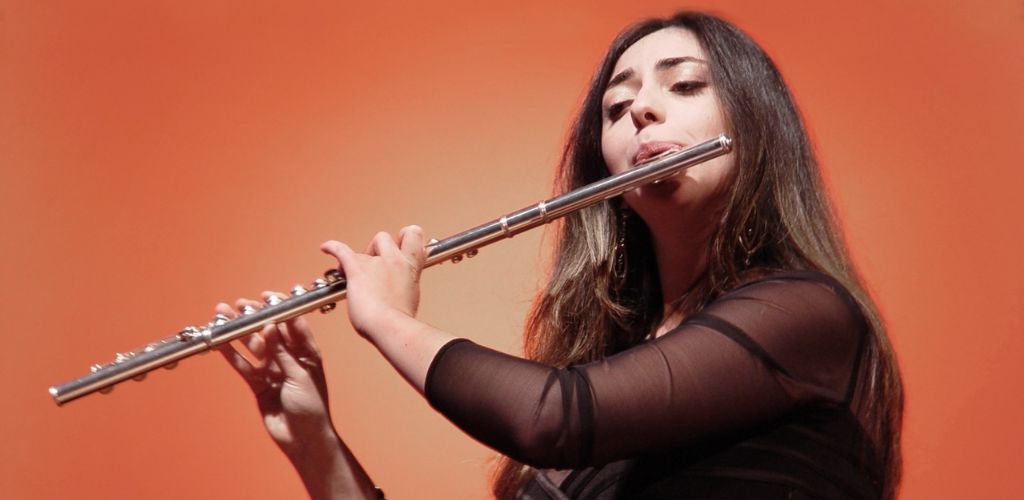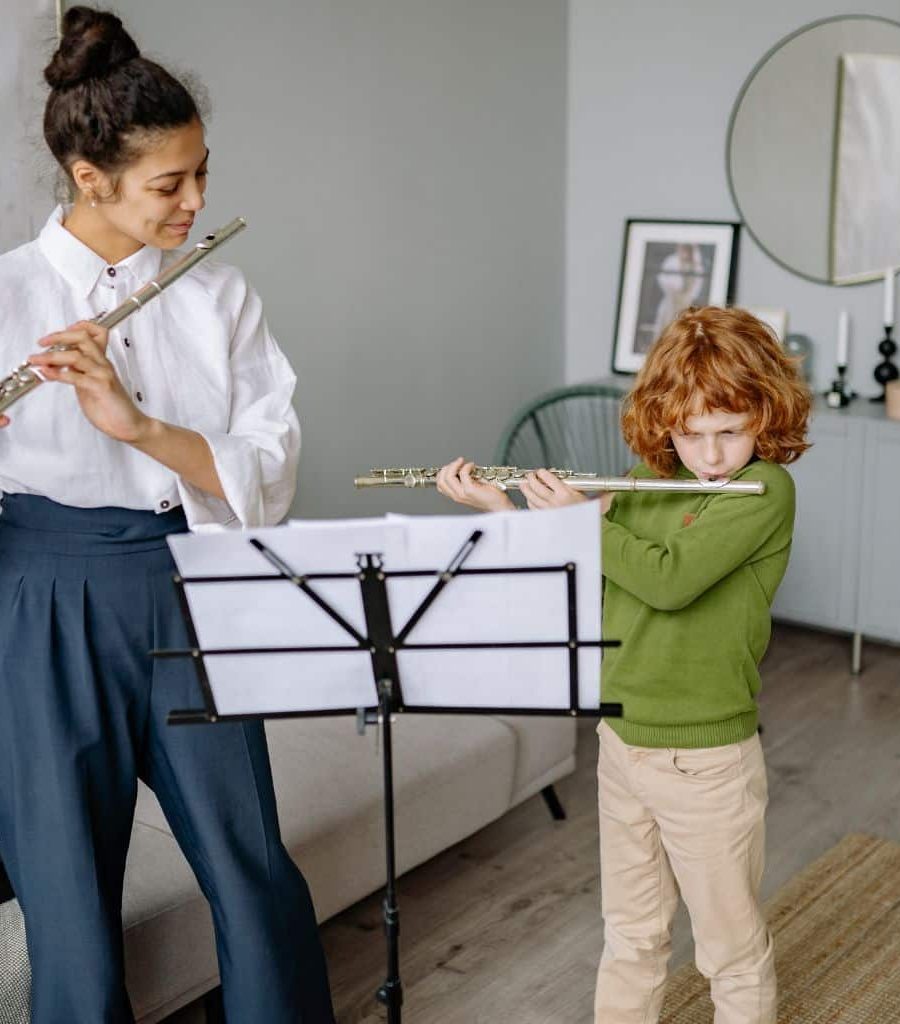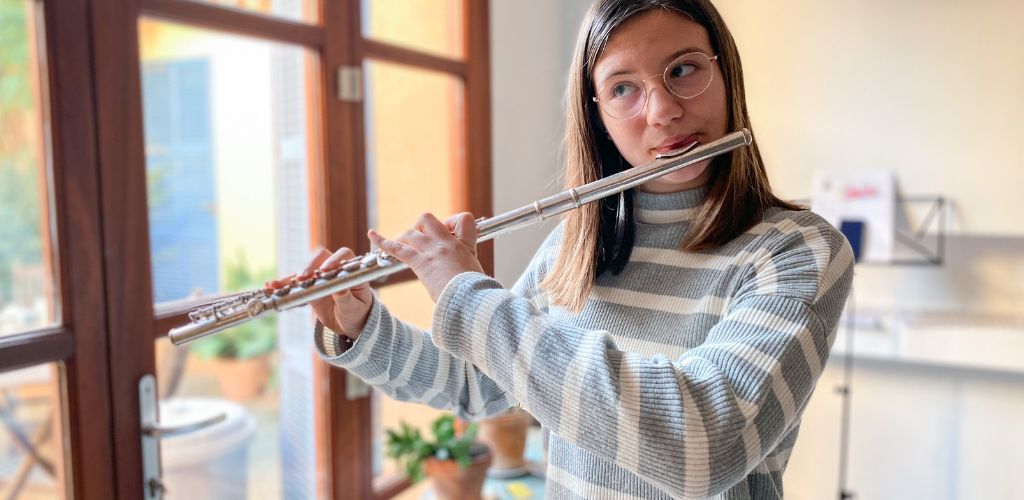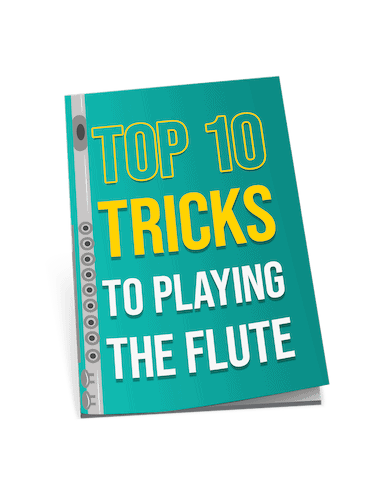Best
Flute For
Beginner
-
Overall: With Genesis head joint.
-
Best Feature: Upgraded mouthpiece with a wide riser angle.
-
TedScore™: 8/10
Best
Overall Flute
-
Overall: Based on Yamaha's Professional Series flutes
-
Best Feature: Nickel silver construction provides increased durability.
-
TedScore™: 9/10
Best
Budget-friendly
Flute
introduction
-
Overall: Closed-hole flute - easier for beginner.
-
Best Feature: Nickel Silver Body.
-
TedScore™: 8/10
If you’re wondering, “How long does it take to learn the flute?” I’ve got news for you: With commitment and consistency, you can gain confidence in playing simple tunes within just a few months!

Learning any new skill is a journey, and with the flute, there are some notes to hit and fingers to dance. But don’t worry; I’ll cover the essentials you’ll need to start making music as swiftly and sweetly as possible.
Explore this article to discover tips, challenges, and what makes each kind of flute unique in its own right.
Mastering the Basics of Flute Playing
Learning to play the flute involves mastering a few key areas. It’s all about understanding the instrument, developing a proper embouchure, and achieving correct posture and finger placement.
Many musicians, regardless of their level, adapt their practice routines and goals based on personal aspirations, whether for recreational enjoyment or performance opportunities.
Understanding Flute Anatomy
Let’s begin with understanding the anatomy of this elegant instrument. A standard concert flute comprises three main parts: the head joint, body, and foot joint.
The head joint includes the essential lip plate, which we use to produce sound. It’s a sleek piece that looks like it’s ready for its close-up!
The body contains most of the keys, making it the heart of your musical experience.
The foot joint adds those lower notes to your repertoire.
There are also various types of flutes, such as the piccolo, alto, and bass, each with its unique charm. We need to appreciate these differences to broaden our musical horizons.

Fundamentals of Flute Embouchure
Achieving the proper embouchure is crucial, as it affects the quality and clarity of the sound.
It involves experimenting with lip tension and airspeed. It can feel like a bizarre game, but once nailed, it opens a world of tonal possibilities.

With time, my lips learn to dance harmoniously with the flute, crafting those sweet, melodic tunes. This isn’t just playing; it’s like having a conversation with the flute!
Posture and Finger Positioning
Getting the posture right is a game changer. Whenever I pick up my flute, I stand or sit tall, keeping my spine straight and shoulders relaxed.
Think of it as a power stance for flute playing. Proper posture is not just about looking cool; it actually enhances control and airflow.

Finger placement, too, is a part of this dance. Each finger has its place, guided by the flute fingering chart.
Gaining muscle memory for these positions frees me to focus on the music itself, creating a seamless flow of notes.
Advancing Your Flute Skills
Improving flute skills and learning to play flute requires a combination of focused practice, strategic learning techniques, and seeking expert guidance.
It’s about building a foundation in breath control and enhancing memory retention while engaging with experienced mentors.
Breath Control and Support

Achieving control over breath is fundamental in playing the flute.
I focus on maintaining a steady airflow, which is the driving force behind producing a clear and consistent sound. It’s like keeping a pot of water at just the right simmer.
An essential exercise involves blowing across the flute with varying intensities to master volume control.
Moreover, it’s crucial to support your sound with the diaphragm, much like opera singers do.
Practicing diaphragmatic breathing can greatly enhance stamina, enabling longer and more nuanced phrases. It’s a lot of huffing and puffing at first, but once you get the hang of it, it feels effortless.
Navigating the Learning Curve and Practice Habits

Keeping pieces of music in your memory is like keeping your wardrobe organized – sometimes challenging but rewarding. Breaking the music into smaller segments and repeating them until they’re second nature.
Adopting a structured practice routine is essential.
The 80/20 rule can help you focus on exercises and pieces that yield the most improvement. A well-organized practice schedule allows consistency without monotony, which I find keeps my enthusiasm and progress intact.
When starting out, it’s essential to focus on developing good habits and avoiding poor technique, which can hinder progress and lead to frustration. Beginners can start by learning simple tunes like “Happy Birthday” and gradually work their way up to more complex pieces and cover songs.
With dedication and consistent practice, even just two hours a week, aspiring flutists can make steady progress in their learning process.
Seeking Guidance from a Good Teacher

One-on-one guidance from a knowledgeable flute teacher can elevate skills remarkably. They offer tailored advice on technique and posture, saving you from potential pitfalls.
By sharing insights on interpretation and style, a teacher can inspire creative expression on several factors. Their watchful eye ensures that I’m on the best path to achieving both sound and style goals.
I find that having someone who notices what I miss makes all the difference in making the most of each practice session.
Best Flute Recommendation
Yamaha YFL-222 Student Flute with Offset G Key System

DESIGNED FOR: Beginners
FEATURES: The design is based on Yamaha's Professional Series flutes.
OTHER INFO: Nickel silver construction provides increased durability and a rich tone.
Yamaha YFL-222 Student Flute with Offset G Key System
- Hand-assembled silver-plated keys.
- Comfortable offset G key system.
- Includes case.
- While some players find the offset G key comfortable, others may prefer an inline G key system, so it's a matter of personal preference.
When you click ‘Check Price’, you’ll see there are loads of great places to buy this item. Our personal favorite is Sweetwater for the US, and Thomann and Gear4Music for the UK & Europe.
They are the largest music retailers, with excellent customer service, competitive prices, really fast shipping, and the longest guarantees.
The professional musician who wrote this article combined many things,
from the product build, manufacturer’s reputation through to feedback
from other users, to create our famous TedScore™.
Stagg FL111 Flute

FEATURES: Closed-hole flute - easier for beginner
OTHER INFO: Nickel Silver Body
- Cost-effective
- Offset G for extra ergonomic design
- It may not be as durable as advanced flute
When you click ‘Check Price’, you’ll see there are loads of great places to buy this item. Our personal favorite is Sweetwater for the US, and Thomann and Gear4Music for the UK & Europe.
They are the largest music retailers, with excellent customer service, competitive prices, really fast shipping, and the longest guarantees.
The professional musician who wrote this article combined many things,
from the product build, manufacturer’s reputation through to feedback
from other users, to create our famous TedScore™.
Jupiter JFL700REC Flute

FEATURES: With Genesis head joint
OTHER INFO: Upgraded mouthpiece with a wide riser angle
- Includes a French case and cover so you're ready to travel
- Maintenance Needs
When you click ‘Check Price’, you’ll see there are loads of great places to buy this item. Our personal favorite is Sweetwater for the US, and Thomann and Gear4Music for the UK & Europe.
They are the largest music retailers, with excellent customer service, competitive prices, really fast shipping, and the longest guarantees.
The professional musician who wrote this article combined many things,
from the product build, manufacturer’s reputation through to feedback
from other users, to create our famous TedScore™.
How Long Does It Take To Learn The Flute:
A Journey of Dedication and Practice
Learning to play a musical instrument, such as the flute, can be a rewarding experience.
As a wind instrument, the flute requires proper technique and regular practice sessions to master. You’ll need to harness a bit of patience and sprinkle in some dedication.

Initial hurdles: Mastering that elusive breath and embouchure. Think of it as taming a dragon with a gentle blow.
Progress stages: Start playing simple tunes in a few months while the road to proficiency is longer.
Time required: It varies. It’s a matter of months to play basic tunes and years to proficiency.
Remember, it’s not about how quickly you succeed but the joy of each musical note you produce. Many musicians adapt their practice routines and goals based on personal aspirations, achieving different milestones such as recreational enjoyment or performance opportunities.
A little humor… Trying to learn the flute in one breath is like trying to eat a whole cake in one bite—not advisable, but undoubtedly amusing to imagine!
In short, put in consistent practice with a touch of tenacity, and you’ll be serenading your neighborhood soon enough.
Wait a second, more insights follow…
If you are looking to start your flute journey, this article provides a comprehensive guide to the best flute brand for beginners. These brands offer quality instruments at an affordable price, ensuring a smooth and enjoyable learning experience.
FAQ's
The time it takes to learn the flute varies depending on factors such as the individual’s dedication, practice habits, and natural aptitude, but it typically takes several years of consistent practice to achieve a high level of proficiency.
Learning to play the flute requires dedication, regular practice, and patience, but with proper instruction and perseverance, it is a rewarding and achievable skill for most people.
The difficulty of playing flute or guitar depends on various factors such as individual aptitude, physical attributes, and dedication to practice, making it subjective to determine which instrument is harder to learn and master.
While it is possible to self-teach the flute to a certain extent, it is highly recommended that you take lessons from a qualified instructor to ensure proper technique, avoid bad habits, and achieve better progress.











yo, just started with the flute and this guide’s lit 🔥 always thought flutes were just for classical stuff but nah, they can drop some sick beats too. props to Robert Emery for the insights!
Regarding the ‘Best Flute Recommendation’ section, while the article provides a solid overview, it’s crucial to highlight that the flute selection largely depends on the individual’s level of expertise, budget, and personal preference. For instance, professionals might prefer handmade flutes from renowned brands like Haynes or Muramatsu, which offer superior tonal quality and craftsmanship but at a higher price point. Beginners, on the other hand, might benefit from student models from Yamaha or Jupiter, which are more cost-effective yet offer good quality for starters. It’s also worth mentioning that exploring second-hand options could be beneficial. Always try before you buy, if possible.
I’ve always admired the beautiful sound of the flute and now that I have more free time, I’ve decided to learn it. The section on ‘Breath Control and Support’ intrigued me. Does anyone have tips on how to improve lung capacity and control? Also, how significant is the role of breath control in playing more complex pieces? Would love to hear thoughts or personal experiences!
ABSOLUTELY essential, can’t stress enough! Especially for those loooong notes. 😊
Breath control is super crucial, Sylvia! Start with basic breathing exercises and gradually increase the difficulty. And yeah, complex pieces need strong breath support for those long passages. Keep practicing, and you’ll see the difference!